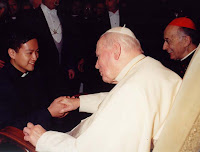 And found Him found Him found Him
And found Him found Him found Him
Found the Hand to hold me up!
He held me like a burning poem
And waved me all over the world.
José Garcia Villa
It was late in the afternoon of January 9 in the Year of the Great Jubilee. It was a Sunday, but I was caught in a traffic jam. I was in the heart of the district of Quiapo. It had not occurred to me that it was the feast of the Black Nazarene. Rather than lose my cool and curse myself for having been at the wrong place at the wrong time, I was in a good mood and was a bit more reflective than usual. I was just there wondering at the sight of the great crowd, a mass of bodies that packed the lane. And they were men, not women. They who gathered were not there expecting edible giveaways; nor were they paid to go there. They were there on their own accord, moving with everybody else, savoring the delight of treading barefoot in procession accompanying the figure of the famous Black Nazarene of Quiapo.
It was the figure of Christ, dressed in maroon robes, that was obviously the star of the show. Some men who had gathered for the event wore the same shade—however faded—for their apparel. Others were half naked and their bodies glistened with sweat. Some were more fortunate as they were able to cling to the statue…
The Black Nazarene of Quiapo is one of the figures of Christ that has earned a place in the hearts of Filipinos, many of whom are of the poorer class. This one and the other figures also of Christ that have attracted numerous devotees throughout the decades, that have steadily asserted through the practices of popular piety that he is deeply embedded into the culture of the Filipino people.
“Gods walk on brown legs”
is how the renowned Filipino poet Rafael Zulueta da Costa ends his poem “Like the Molave.” I would like to make an adaptation of this: God walks on brown legs. In the quest for an inculturated Christ, the Filipino himself looks for someone who is like him--not only in color (although he can easily relate to a Christ who shares with him even the color of his skin), but more than that. The Filipino looks for a person who is like him: lowly, suffering, an underdog, burdened with a cross. To earn exaltation, he had to look for the Hand that would lift him up. And in the figures of Christ that they hold dear, the Filipinos “found Him found Him found Him.” And in the figures of Christ that they hold dear like the Black Nazarene, the Filipinos have found God to be this hand. Through popular piety, men and women have sought for God and found Him.I remember one afternoon when in a seminar-workshop on popular religiosity I sat a-pondering in the multi-media hall of the Maryhill School of Theology, when I thought of the millions of Filipinos who wanted to touch Christ. Touch him—they did, literally, or others must have thought they did, but did not in actuality. I sat in a trance, for I was convinced that they did touch him after all. Their hands on the image, their knees on the floor—aye, they touched him. Theirs was the experience that theological speculation might never give them. I blurted out to myself: “Personally, I’d rather have a people steeped in religiosity, in a seemingly exaggerated expression, than a godless people.”
Now I am convinced: this piety that they have is a treasure for it is a given, a raw material. With this in one’s hands, that person can do much. It is a long, tedious process, but yes, it is a power possible. And bring it before God’s hands—it is power invincible.

No comments:
Post a Comment